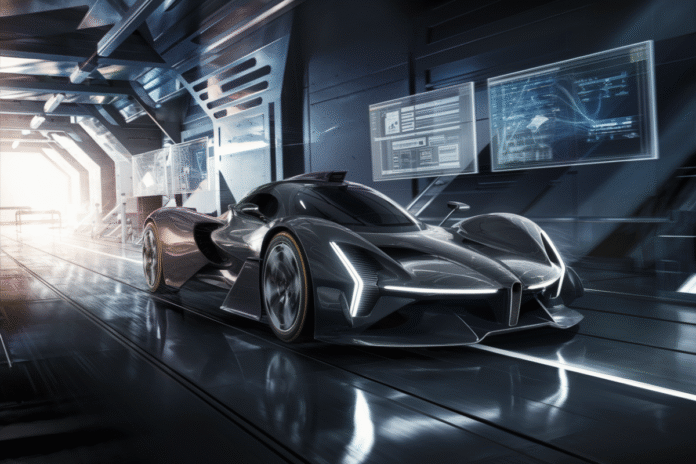“Ford Racing has made a bold declaration regarding its future in motorsport.” The decision to manage its World Endurance Championship Hypercar program internally signals a significant shift in strategy for the manufacturer. As competition intensifies in the realm of endurance racing, manufacturers are increasingly seeking ways to enhance their performance and innovation. This move raises questions about the potential impact on the racing landscape and Ford’s ability to compete against established rivals. Can an in-house approach deliver the results needed to succeed in such a challenging environment?
With the growing popularity of endurance racing, the stakes have never been higher. Manufacturers are not only vying for victory on the track but also for technological supremacy that can translate into commercial success. Ford’s commitment to an in-house Hypercar program indicates a desire to control every aspect of the vehicle’s development, from engineering to design. This strategic pivot could allow Ford to leverage its extensive resources and expertise, potentially positioning it as a formidable contender in the championship. As the automotive industry evolves, how will this decision shape Ford’s future in motorsport and its overall brand image?
Ford’s Strategic Shift in Motorsport
The decision to run the Hypercar program in-house marks a pivotal moment for Ford Racing. Historically, many manufacturers have opted to partner with specialized teams or external suppliers to develop their racing vehicles. However, Ford’s choice to take full control suggests a renewed confidence in its engineering capabilities. This shift allows Ford to streamline processes, ensuring that every aspect of the Hypercar aligns with its racing philosophy. By managing the program internally, Ford can make rapid adjustments based on real-time data and feedback from the track, enhancing its competitive edge.
Moreover, the in-house approach enables Ford to integrate its latest technological advancements directly into the Hypercar. This could include innovations in aerodynamics, hybrid powertrains, and lightweight materials. The ability to harness cutting-edge technology is crucial in endurance racing, where efficiency and performance are paramount. Ford’s engineers can collaborate closely, fostering a culture of innovation that may yield breakthroughs not only for the Hypercar but for future road vehicles as well.
As Ford embarks on this journey, it faces the challenge of competing against well-established teams with extensive experience in the World Endurance Championship. Rivals have spent years honing their strategies and technologies, making the path ahead for Ford both exciting and daunting. However, the potential rewards of success—both on the track and in the marketplace—could redefine Ford’s position in the motorsport arena.
The Implications for Competitive Racing
The implications of Ford’s decision extend beyond its own operations; they resonate throughout the entire World Endurance Championship. By bringing the Hypercar program in-house, Ford is likely to inspire other manufacturers to consider similar strategies. This could lead to a shift in the competitive landscape as more companies seek to gain an advantage through direct control over their racing programs. The result may be a more dynamic and unpredictable championship, where innovation and strategy play increasingly crucial roles.
Additionally, this move could impact partnerships within the racing community. As Ford takes on more responsibilities, it may reevaluate existing collaborations with suppliers and technical partners. The focus on in-house development may foster a spirit of competition among manufacturers, pushing each to elevate their performance standards. This competitive environment can lead to rapid advancements in technology, benefiting not only the teams involved but also the broader automotive industry.
Ultimately, Ford’s commitment to its Hypercar program could serve as a catalyst for change in endurance racing. As manufacturers respond to Ford’s bold move, the championship may witness a new era of innovation and rivalry. Fans can anticipate thrilling races as teams push the limits of engineering and strategy, resulting in a spectacle that captivates audiences worldwide.
Technological Innovations on the Horizon
Ford’s in-house Hypercar program is poised to introduce significant technological innovations that could redefine endurance racing. The integration of advanced materials, such as carbon fiber and lightweight composites, will enhance performance while maintaining structural integrity. These materials contribute to improved aerodynamics and fuel efficiency, both critical factors in endurance racing.
Furthermore, Ford is likely to focus on hybrid powertrain technology, which has become increasingly prevalent in motorsport. By developing a sophisticated hybrid system, the Hypercar could achieve remarkable performance while adhering to sustainability goals. This approach not only aligns with global trends toward eco-friendly technologies but also offers a competitive advantage in races, where fuel efficiency can be a decisive factor.
As Ford invests in research and development, the potential for groundbreaking innovations increases. The insights gained from the Hypercar program may translate into enhancements for Ford’s consumer vehicles, reinforcing the company’s commitment to performance and sustainability. This symbiotic relationship between racing and commercial development can create a virtuous cycle, where success on the track drives advancements in everyday vehicles.
The Future of Ford Racing
Looking ahead, Ford Racing’s decision to manage its Hypercar program in-house reflects a broader trend within the automotive industry. As manufacturers strive for greater control over their racing endeavors, the landscape of motorsport is evolving. Ford’s commitment to innovation and performance positions it as a key player in this transformation, with the potential to influence the future of endurance racing.
Moreover, the success of the Hypercar program could have far-reaching implications for Ford’s brand image. A strong performance in the World Endurance Championship would not only elevate Ford’s status within the racing community but also resonate with consumers. As fans witness Ford’s dedication to excellence and innovation, it may bolster their loyalty to the brand, translating into increased sales and market share.
Ultimately, Ford Racing’s in-house approach to the Hypercar program signals a new chapter in the company’s storied history. As the team embarks on this ambitious journey, the automotive world will be watching closely. The outcomes of this strategic decision could redefine not only Ford’s legacy in motorsport but also the future of endurance racing as a whole.


